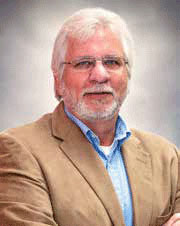The University of Nevada, Las Vegas has a student population of approximately 28,000 and 300-plus learning spaces with AV installed. Classroom Technology Services is a small group of five dedicated professional employees with a shared mission to reduce lost class time due to equipment failure. AV Technology was fortunate to speak with UNLV's Classroom Technology Manager, Scott F. Mentor, CTS, to learn about higher ed collaboration strategies.

Scott F. Menter, CTS, Classroom Technology Services Manager, Information Technology, Instructional Technology Services, University of Nevada, Las VegasAV Technology editors: How is AV/IT convergence playing out in your university?
Scott Menter: AV/IT convergences has been in play for some time now. I came up in the AV side if the industry. I have been working with AV and IT for over 35 years. I have seen the convergence slowly integrate in systems, and now with the digital realm, IT has become a larger part of the systems we install and maintain.
In my opinion, AV is the primary of the two. In any large educational institutions, the main focus is the faculty and student needs. They still just want to see the image on the screen and be able to hear the instructor. How the A and V get there is not their concern. It’s ours.
Today’s environment relies on the IT infrastructure to transport and monitor the AV. The typical AV person now requires a vast knowledge IT. The problem is finding programmers that have the AV knowledge base. What we have done is grow our own AV techs out of the IT world.
What AV/IT problems have you solved recently?
We don’t have problems, we have solutions.
In developing the department as a whole, we found it necessary to configure a server application to monitor and control the systems in the classrooms. This really helps with the response time if we can fix the problem remotely or part of the troubleshooting process. In addition to the remote control and system status, we were able to develop scripts to monitor the number of button presses and time of use each device, warn us of if a lamp is getting close to end of life and auto shut off when not in use.
What types of new tech do you want to learn more about?
I like to learn about new applications that can improve teaching and learning. When the needs are identified, we look at the technology that most satisfies those needs. Working in a university environment, you come across very specific and sometimes very unique applications; e.g. video walls, motion capture golf swing analyzer, counseling recording rooms, and lecture capture.
I had a professor tell me a long time ago in an electronics class, “If you know the basics, rely on learning what you know when you need to know it.” It is every so true now that technology changes so fast.
What AV/IT do you hope to buy in the near future?
I am always looking for solutions to enhance teaching and learning. Everyone wants to BYOD (Bring Your Own Device) to connect wirelessly to the display.
I have been looking and evaluating products that claim they are the answer. But each one has its own limitations. If it’s because of price or there is that one device that cannot easily connect.
The manufacturers of these devices are really close but not ready for prime time. I have to look at support of the product as well as the ease of use and be comfortable in recommending it to my colleagues.
Where are tech manufacturers getting it wrong or missing opportunities?
There are some manufacturers that are willing to solicit feedback from the end user in product development, but I believe that most do not. Even when manufacturers ask for your opinion, you rarely see the recommendations implemented in the product.
What is the biggest obstacle to collaboration?
The biggest obstacle is the lack of just sitting down and talk to someone. Email, Text, VTC and all the communication tools out there can be used to supplement collaboration but it is hard to replace face-to-face time.
What are your collaboration strategies?
Creating a supportive environment is one key to success, one in which all employees understand their roles and the roles of others. Another is investing in your personnel through training where they bring back fresh ideas and enthusiasm that is shared with others. I am lucky to be part of a group that see value in each other as a resource. In our group, everyone has a seat at the table.











